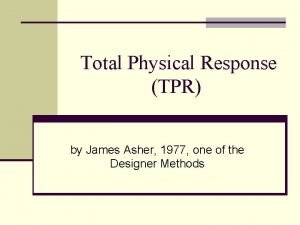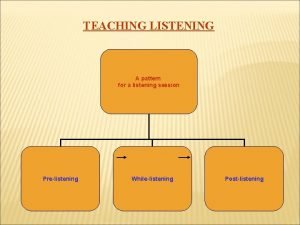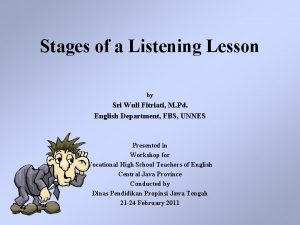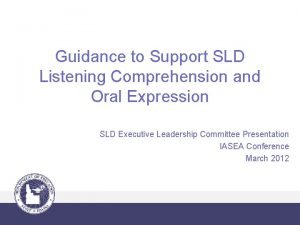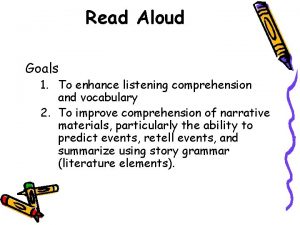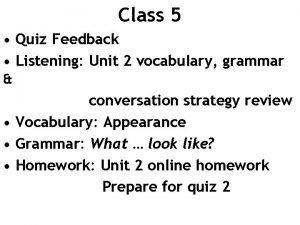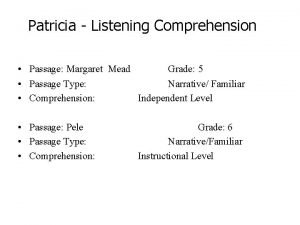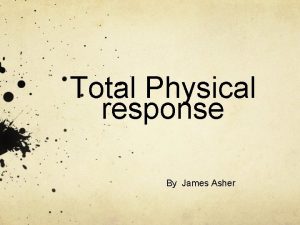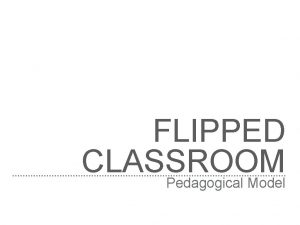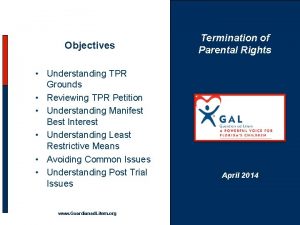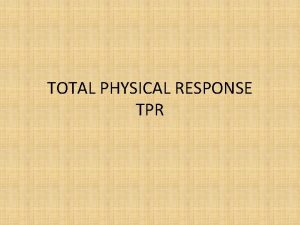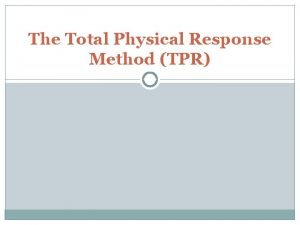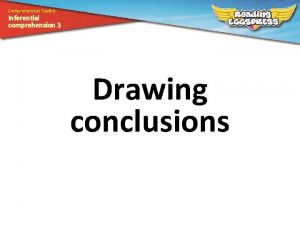Listening Comprehension in Pedagogical Research TPR James Asher













- Slides: 13

Listening Comprehension in Pedagogical Research TPR James Asher (1977) learners were given great quantities of language to listen to before they were encouraged to respond orally Natural Approach, Stephen Krashen (1982) Learners need not say anything during “silent period” until they feel ready to do so

Questions about Listening What are listeners ‘doing’ when they listen? What factors affect good listening? What are the characteristics or ‘real life’ listening? What are the many things listeners listen for? What are some principles of designing listening techniques? How can listening techniques be interactive? What are some common techniques for teaching listening?

Processes involved in Comprehension (Clark& Clark, 1977 and Richards, 1983) 1. 2. 3. 4. The hearer processes “raw speech” and “holds” an image of it in short term memory (phrases, clauses, cohesive markers, intonation and intonation) The hearer determines the type of speech event (conversation, speech, radio broadcast etc) The hearer infers the objectives of the speaker through consideration of the type of the speech event, the context, and content. The hearer recall background information relevant to the context and subject matter

Processes involved in Comprehension (Clark& Clark, 1977 and Richards, 1983) The hearer assigns a literal meaning to the utterance. (E. g. Do you have time? ) The hearer assigns an intended meaning to the utterance The hearer determines whether information should be retained in short-term or long-term memory. (simple conversation and lecturing) The hearer deletes the form in in which the message was originally received.

Types of Spoken Language Dialogue Monologue Planned Unplanned Unfamiliar Interpersonal Familiar Unfamiliar Transactional Familiar

What Makes Listening Difficult 1. 2. 3. 4. Clustering due to memory limitation and our predisposition for chunking or clustering, we break down speech into smaller groups of words Redundancy Rephrasing, repetitions, elaborations and more time and extra information can be boring Reduced Forms Phonological, morphological, syntactic or pragmatic Performance Variables Hesitations, false starts, pauses and corrections

What Makes Listening Difficult 5. Colloquial Language Idioms, slang, reduced forms are difficult point to deal 6. Rate of Delivery Native speaker speak too fast 7. Stress, rhythm and intonation Subtle messages like sarcasm, endearment, insult, solicitation, praise etc. 8. Interaction Negotiation, clarification, attending signals, turn taking, topic nomination, maintenance and termination

Microskills of Listening Comprehension Retain chunks of language of different lengths in shortterm memory Discriminate among the distinctive sounds of English Recognize English stress patterns, words in stressed and unstressed position, rhythm etc Recognize reduced forms of words Distinguish word boundaries, core of words, interpretation etc Process speech at different rates of delivery Process speech containing pauses, errors, corrections etc Recognize grammatical word classes and systems

Microskills of Listening Comprehension Recognize that a particular meaning be expressed in different grammatical form Recognize cohesive devices in spoken discourse Recognize the communicative functions of utterance, according to situation, participants and goal Infer situations, participants, goals using real knowledge Distinguish between literal and implied meaning Use facial, kinesic, body language, etc. Develop listening strategies, such as detecting key words, guessing the meaning etc.

Types of Classroom Listening Performance Reactive Individual drills that focus on pronunciation Intensive focus on components (phonemes, words, intonation, discourse markers etc) Responsive activities designed to elicit immediate responses Selective Select certain material such as in speeches, media broadcasts, stories, anecdotes, conversations etc Extensive Develop top down, global understanding of spoken language Interactive Listening performance include all types (debates, role plays etc. )

Principles for Designing Listening Techniques should be intrinsically motivating Techniques should utilize authentic language and contexts Carefully consider the form of listeners’ responses Encourage the development of listening strategies Include both bottom-up and top-down listening techniques

Goo d luc k ‘N See you

Have a wonderful trip!
 Tpr theory of language
Tpr theory of language Pre listening while listening and post listening
Pre listening while listening and post listening Pre listening stage
Pre listening stage Natural disasters listening comprehension
Natural disasters listening comprehension What is testing listening
What is testing listening Rubrics for listening skills
Rubrics for listening skills Sld listening comprehension
Sld listening comprehension Listening comprehension goals
Listening comprehension goals Unit 2 quiz: listening comprehension
Unit 2 quiz: listening comprehension Section 1: listening comprehension
Section 1: listening comprehension Social media listening comprehension
Social media listening comprehension Let's practice listening comprehension
Let's practice listening comprehension Unit 15 quiz listening comprehension
Unit 15 quiz listening comprehension Listening comprehension grade 5
Listening comprehension grade 5
